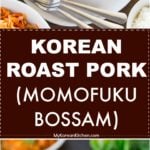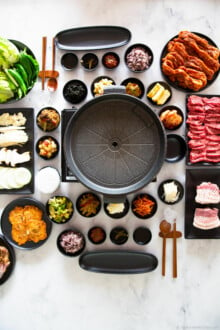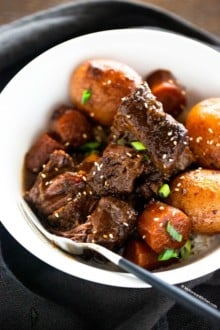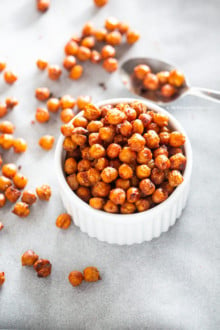Make Korean fusion style Bo Ssam at home and fall in love with the bo ssam miracle!
I finally tried the famous Momofuku bo ssam recipe at home. This bo ssam recipe is developed by Chef David Chang and ever since it’s been hugely popular, particularly in the United States.
Essentially Momofuku bo ssam is slow roasted pork shoulder. Bone-in pork shoulder is dry rubbed with generous amounts of salt and sugar then cured overnight. Then it is slow roasted in the oven for about 6 hours.
And then, it is finished off with another layer of dark brown sugar to caramelize the outer layer of the pork, giving it a nicely burnt sugar aroma and crunchy texture.
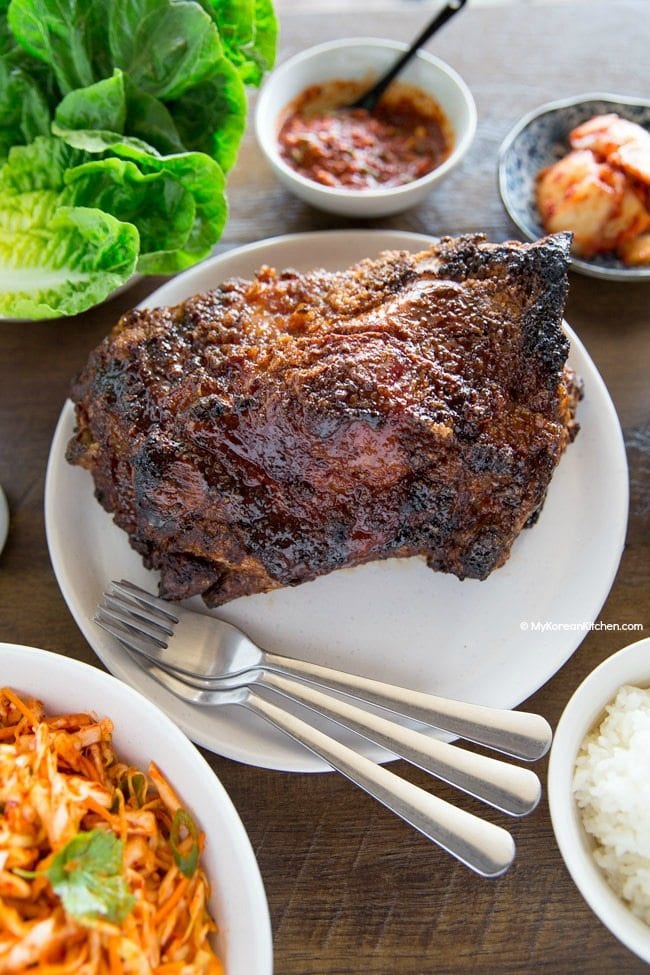
Inevitably, inside, the roasted pork is super tender and moist. It is almost collapsible and the meat falls off the bone very easily.
Traditionally, though, Bo Ssam / Bossam (보쌈) refers to a boiled pork dish with other herbs and seasonings. So in essence, there’s nothing alike between these two dishes.
However, the way Bo Ssam / Bossam is served with some fresh lettuce leaves to wrap around is the same. Also, they both are accompanied with dipping sauce – aka ssam sauce and some kimchi.
Momofuku’s bo ssam is a great dish to serve when you’re planning to entertain your guests. That’s why I’ve already tried this recipe 4 times within the last 30 days! Because I’m hoping to serve it during this Christmas holiday period, so I’ve been practising. 😉
Making the slow roasted pork is very easy and straight forward. Assembling all the sauces and accompaniments are easy too (as long as you understand the ingredients used.) So why not use this recipe to feast your family and friends? Hope you enjoy!
P.S. If you’re after more traditional style Korean bossam, check here. [Bossam recipe]
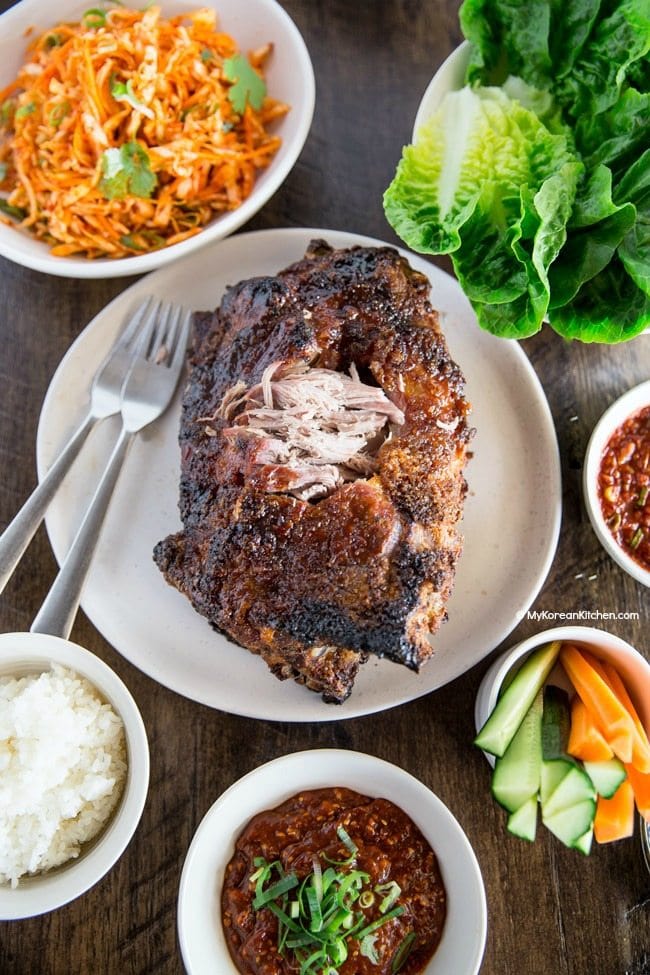
Ingredients for Momofuku Bo Ssam (Serves 6 to 12)
Pork Shoulder
- 3.5 kg – 4.5 kg (8 to 10 pounds) one whole pork shoulder / pork butt – ideally bone-in and has some fat
- 1 cup (white or raw) sugar
- 1 cup & 1 Tbsp fine sea salt, divided
- 7 Tbsp brown sugar
- 2 tsp apple cider vinegar
Salted Shrimp Sauce (Optional)
- 2 Tbsp Korean salted shrimps (saeujeot), finely chopped
- 1 Tbsp gochugaru (Korean chili flakes)
- 1 Tbsp rice wine
- 1 Tbsp castor sugar
- 1 tsp sesame oil
- 1/2 stalk green onion, finely chopped
Ssam Sauce
- 1/4 cup doenjang (korean soybean paste)
- 2 Tbsp gochujang (korean chili paste)
- 2 Tbsp sesame oil
- 1/2 Tbsp honey
- 2 tsp sesame seeds
- 1/2 tsp minced garlic
- 10 g onion, chopped
- (optional) 2 Tbsp walnuts or your choice of nuts – this will add more nutty flavor and creamier texture.
- 1 Tbsp green onion, thinly sliced
*see note below for alternative ssam sauce option
Other Accompaniments
- steamed rice
- lettuce (I used baby cos lettuce. You can also use bibb lettuce.)
- kimchi (use these recipes napa kimchi salad and/or quick radish kimchi or buy)
- spicy korean coleslaw (use this recipe)
** 1 Tbsp = 15 ml, 1 Cup = 250 ml
*** If you want to learn about Korean ingredients, check my Korean essential ingredients list!
How to Make Momofuku Bo Ssam
1. Place the pork in a large shallow tray. (Roasting pan or lasagna baking dish works great!) Combine 1 cup of sugar and 1 cup of the salt in a bowl and mix them well. Gently rub the mixture all over the meat. Cover it with plastic wrap then refrigerate it at least 6 hours or overnight.
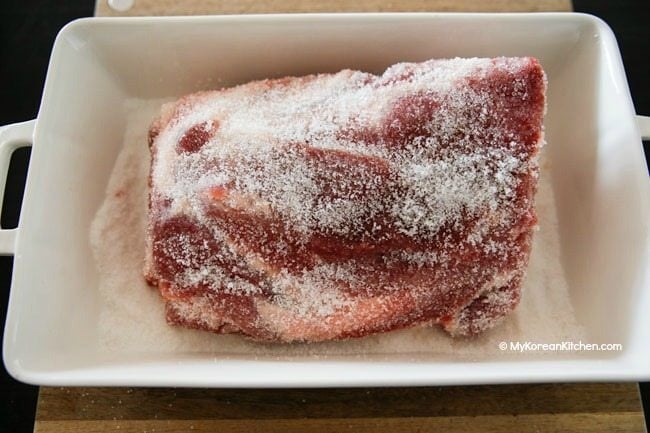
2. When you’re ready to cook, heat the oven to 150 C / 300 F. Cover the roasting pan with cooking foil. Wrap it around at least twice covering all the gaps. (You will thank me later! This will make your cleaning process so much easier.) Remove the pork from the fridge and discard any juice. Leave the rub on the pork.
Place the pork in a roasting pan (fatty side up if any), set in the oven and cook it for about 6 hours. (This can vary depending on the size of the pork. See note below for guidance.) Once cooked, the pork should be very easy to pull apart with tongs and forks. Remove the pork from the oven.
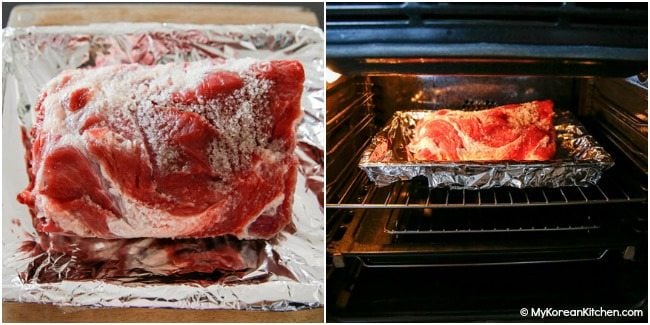
3. While the pork is roasting, make the salted shrimp sauce. Combine all the ingredients in a small bowl and mix. Refrigerate it until needed.

4. Make the ssam sauce. Place all ingredients, except for the green onion, in a food processor and blend until well combined. Garnish with the green onion. Refrigerate it until needed.
5. Prepare other accompaniments as needed. What’s mentioned above is my recommendation, not what’s required.
6. Combine the remaining salt, brown sugar and vinegar in a small bowl. Mix them well. Gently rub the mixture all over the cooked pork (mainly the top of the pork). Watch out for your hands as you rub as the meat can be hot. I wore a food preparation glove for this process.
Turn the oven to 260 C / 500 F (or use a grill / broiler function). Place the pork in the oven and cook it until a dark caramel crust develops on the meat. It takes 5 to 10 mins. Serve hot, with the accompaniments.
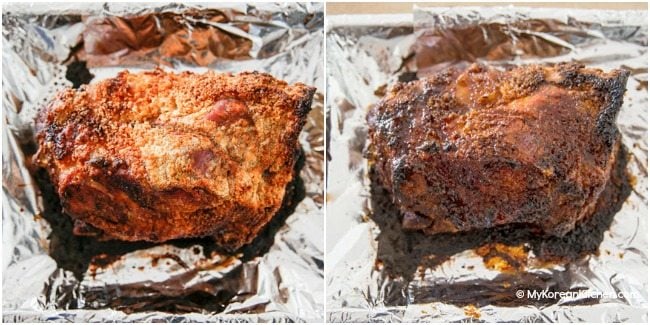
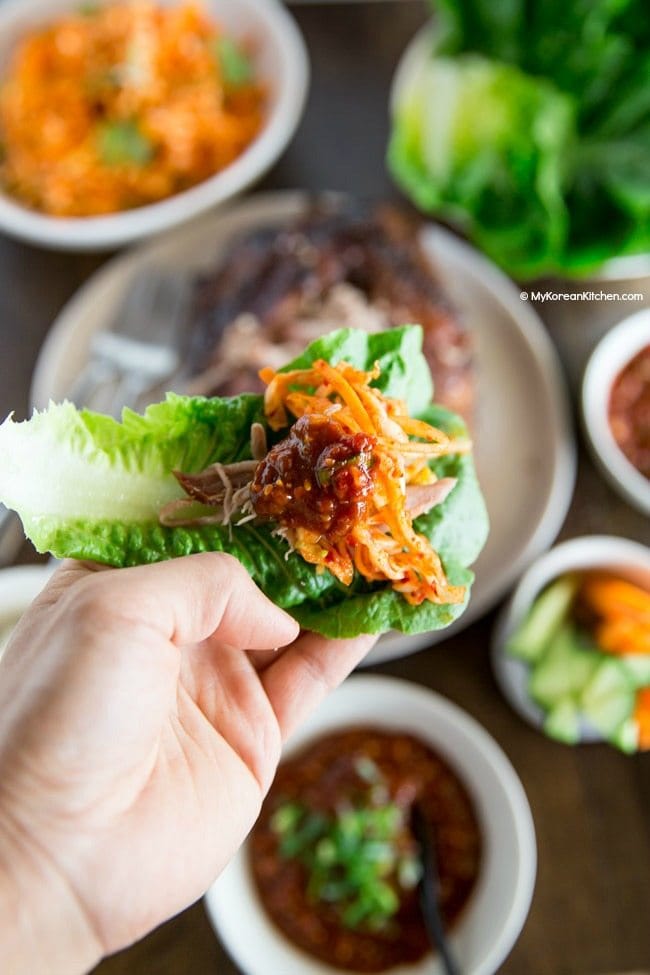
Note
- If you’re using a smaller meat, you will have to reduce the rub ingredients (e.g. sugar, salt etc) and also the cooking time. As a guideline it takes about 4 hours to 4.5 hours to roast 2 kg / 4.4 pounds bone-in pork shoulder.
- When you first pull off the pork, it’s very moist and tender, but it dries out fairly fast (like within 20 mins)! So serve immediately and eat up. It still tastes good though!
- I normally prepare the sauce and other accompaniments within the first hour of roasting. I find it easier as I can pay my full attention to the meat in the later hour.
- For an even easier ssam sauce option, you can buy this ssamjang tub instead of making it from scratch at home. While you can serve it as it is, I prefer adding small drops of sesame oil and sesame seeds to give an extra nutty flavor.
**** This roasted pork shoulder recipe is adapted from NY Times’ momofuku bo ssam recipe. Salted shrimp sauce and Ssam sauce recipes are my own.
Love Korean food? Browse lots more Korean recipes from my easy Korean recipe collections. And subscribe to my newsletter and follow along on Facebook, Pinterest and Instagram for all of the latest updates.
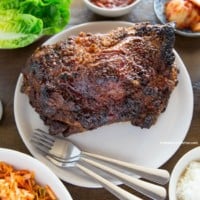
Momofuku Bo Ssam
Ingredients
PORK SHOULDER
- 3.5 - 4.5 kg pork shoulder (8 to 10 pounds), ideally bone-in and has some fat
- 1 cup sugar (white or raw)
- 1 cup fine sea salt
- 1 Tbsp fine sea salt
- 7 Tbsp brown sugar
- 2 tsp apple cider vinegar
SALTED SHRIMP SAUCE (OPTIONAL)
- 2 Tbsp Korean salted shrimps (saeujeot), finely chopped
- 1 Tbsp gochugaru (Korean chili flakes)
- 1 Tbsp rice wine
- 1 Tbsp castor sugar
- 1 tsp sesame oil
- 1/2 stalk green onion , finely chopped
SSAM SAUCE
- 1/4 cup doenjang (korean soybean paste)
- 2 Tbsp gochujang (korean chili paste)
- 2 Tbsp sesame oil
- 1/2 Tbsp honey
- 2 tsp toasted sesame seeds
- 1/2 tsp minced garlic
- 10 g onion , chopped
- 2 Tbsp walnuts or your choice of nuts – this will add more nutty flavor and creamier texture (optional)
- 1 Tbsp green onion , thinly sliced
OTHER ACCOMPANIMENTS
- steamed rice
- lettuce (I used baby cos lettuce. You can also use bibb lettuce.)
- kimchi
- spicy korean coleslaw
Instructions
- Place the pork in a large shallow tray. (Roasting pan or lasagna baking dish works great!) Combine 1 cup of sugar and 1 cup of the salt in a bowl and mix them well. Gently rub the mixture all over the meat. Cover it with plastic wrap then refrigerate it at least 6 hours or overnight.
- When you’re ready to cook, heat the oven to 150 C / 300 F. Cover the roasting pan with cooking foil. Wrap it around at least twice covering all the gaps. (You will thank me later! This will make your cleaning process so much easier.) Remove the pork from the fridge and discard any juice. Leave the rub on the pork.Place the pork in a roasting pan (fatty side up if any), set in the oven and cook it for about 6 hours. (This can vary depending on the size of the pork. See note above for guidance.) Once cooked, the pork should be very easy to pull apart with tongs and forks. Remove the pork from the oven.
- While the pork is roasting, make the salted shrimp sauce. Combine all the ingredients in a small bowl and mix. Refrigerate it until needed.
- Make the ssam sauce. Place all ingredients, except for the green onion, in a food processor and blend until well combined. Garnish with the green onion. Refrigerate it until needed.
- Prepare other accompaniments as needed. What’s mentioned above is my recommendation, not what’s required.
- Combine the remaining salt, brown sugar and vinegar in a small bowl. Mix them well. Gently rub the mixture all over the cooked pork (mainly the top of the pork). Watch out for your hands as you rub as the meat can be hot. I wore a food preparation glove for this process.Turn the oven to 260 C / 500 F (or use a grill / broiler function). Place the pork in the oven and cook it until a dark caramel crust develops on the meat. It takes 5 to 10 mins. Serve hot, with the accompaniments.
Notes
Nutrition Info (per serving)
The nutrition information shown is an estimate provided by an online nutrition calculator. It should not be considered a substitute for a professional nutritionist’s advice.
